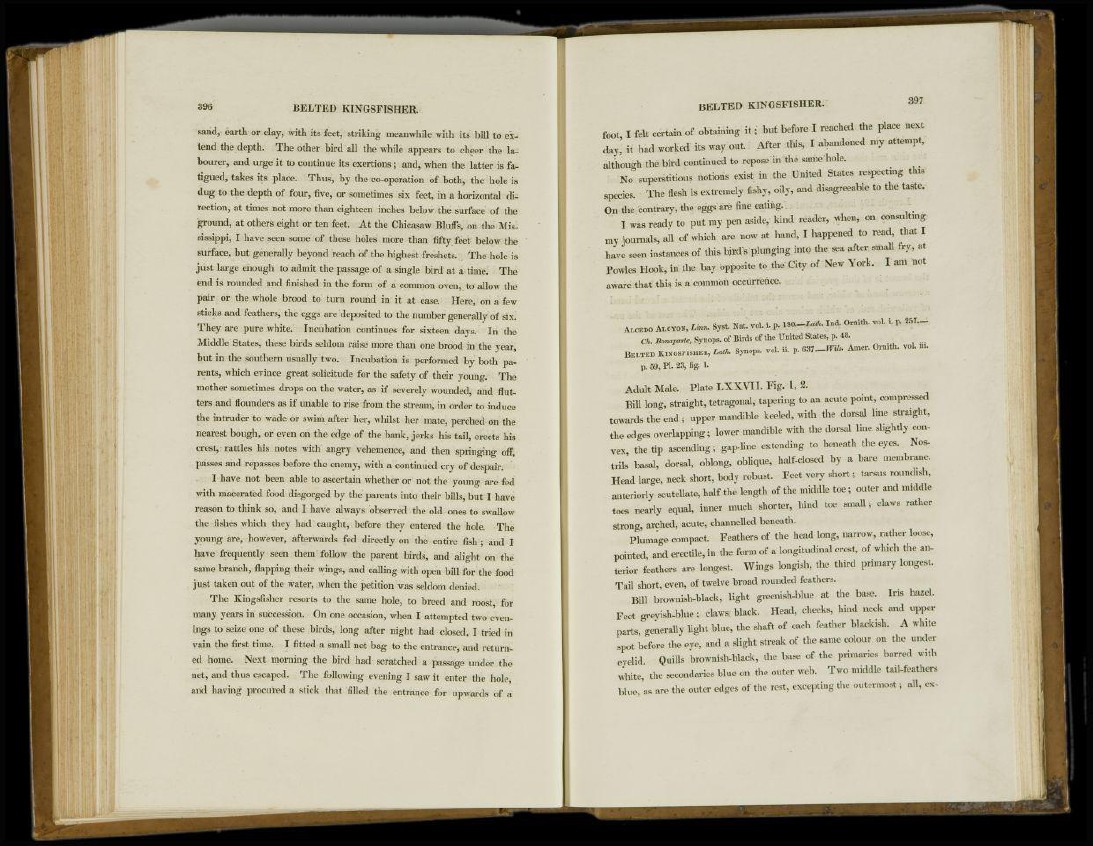
396 BELTED KINGSFISHER.
sand, earth or clay, with its feet, striking meanwhile with its bill to extend
the depth. The other bird all the while appears to cheer the labourer,
and urge it to continue its exertions; and, when the latter is fatigued,
takes its place. Thus, by the co-operation of both, the hole is
dug to the depth of four, five, or sometimes six feet, in a horizontal direction,
at times not more than eighteen inches below the surface of the
ground, at others eight or ten feet. At the Chicasaw Bluffs, on the Mississippi,
I have seen some of these holes more than fifty feet below the
surface, but generally beyond reach of the highest freshets. The hole is
just large enough to admit the passage of a single bird at a time. The
end is rounded and finished in the form of a common oven, to allow the
pair or the whole brood to turn round in it at ease. Here, on a few
sticks and feathers, the eggs are deposited to the number generally of six.
They are pure white. Incubation continues for sixteen days. In the
Middle States, these birds seldom raise more than one brood in the year,
but in the southern usually two. Incubation is performed by both parents,
which evince great solicitude for the safety of their young. The
mother sometimes drops on the water, as if severely wounded, and flutters
and flounders as if unable to rise from the stream, in order to induce
the intruder to wade or swim after her, whilst her mate, perched on the
nearest bough, or even on the edge of the bank, jerks his tail, erects his
crest, rattles his notes with angry vehemence, and then springing off,
passes and repasses before the enemy, with a continued cry of despair.
I have not been able to ascertain whether or not the young are fed
with macerated food disgorged by the parents into their bills, but I have
reason to think so, and I have always observed the old ones to swallow
the fishes which they had caught, before they entered the hole. The
young are, however, afterwards fed directly on the entire fish ; and I
have frequently seen them follow the parent birds, and alight on the
same branch, flapping their wings, and calling with open bill for the food
just taken out of the water, when the petition was seldom denied.
The Kingsfisher resorts to the same hole, to breed and roost, for
many years in succession. On one occasion, when I attempted two evenings
to seize one of these birds, long after night had closed, I tried in
vain the first time. I fitted a small net bag to the entrance, and returned
home. Next morning the bird had scratched a passage under the
net, and thus escaped. The following evening I saw it enter the hole,
and having procured a stick that filled the entrance for upwards of a
BELTED KINGSFISHER. 397
foot, I felt certain of obtaining i t ; but before I reached the place next
day, it had worked its way out. After tins, I abandoned my attempt,
although the bird continued to repose in the same hole.
No superstitious notions exist in the United States respecting this
species. The flesh is extremely fishy, oily, and disagreeable to the taste.
On the contrary, the eggs are fine eating.
I was ready to put my pen aside, kind reader, when, on Consulting
my journals, all of which are now at hand, I happened to read, that I
have seen instances of this bird's plunging into the sea after small fry, at
Powles Hook, in the bay opposite to the City of New York. I am not
aware that this is a common occurrence.
ALCEDO ALCYON, Linn. Syst. Nat. vol. i. p. 180—Lath. Ind. Ornith. vol. i. p. 257.—
Ch. Bonaparte, Synops. of Birds of the United States, p. 48.
BELTED KIJJGSFISHER, Lath. Synops. voL ii. p. G37-—Wils. Amer. Ornith. vol, iii.
p. 59, PI. 23, fig. 1.
Adult Male. Plate LXXVII. Fig. I, 2.
Bill long, straight, tetragonal, tapering to an acute point, compressed
towards the end; upper mandible keeled, with the dorsal line straight,
the edges overlapping; lower mandible with the dorsal line slightly convex,
the tip ascending; gap-line extending to beneath the eyes. Nostrils
basal, dorsal, oblong, oblique, half-closed by a bare membrane.
Head large, neck short, body robust. Feet very short; tarsus roundish,
anteriorly scutellate, half the length of the middle toe ; outer and middle
toes nearly equal, inner much shorter, hind toe small; claws rather
strong, arched, acute, channelled beneath.
Plumage compact. Feathers of the head long, narrow, rather loose,
pointed, and erectile, in the form of a longitudinal crest, of which the anterior
feathers are longest. Wings longish, the third primary longest.
Tail short, even, of twelve broad rounded feathers.
Bill brownish-black, light greenish-blue at the base. Iris hazel.
Feet greyish-blue; claws black. Head, cheeks, hind neck and upper
parts, generally light blue, the shaft of each feather blackish. A white
spot before the eye, and a slight streak of the same colour on the under
eyelid. Quills brownish-black, the base of the primaries barred with
white, the secondaries blue on the outer web. Two middle tail-feathers
blue, as are the outer edges of the rest, excepting the outermost; all, ex